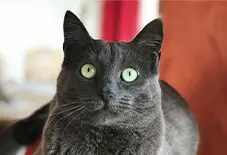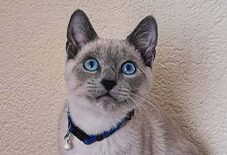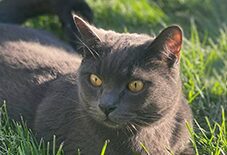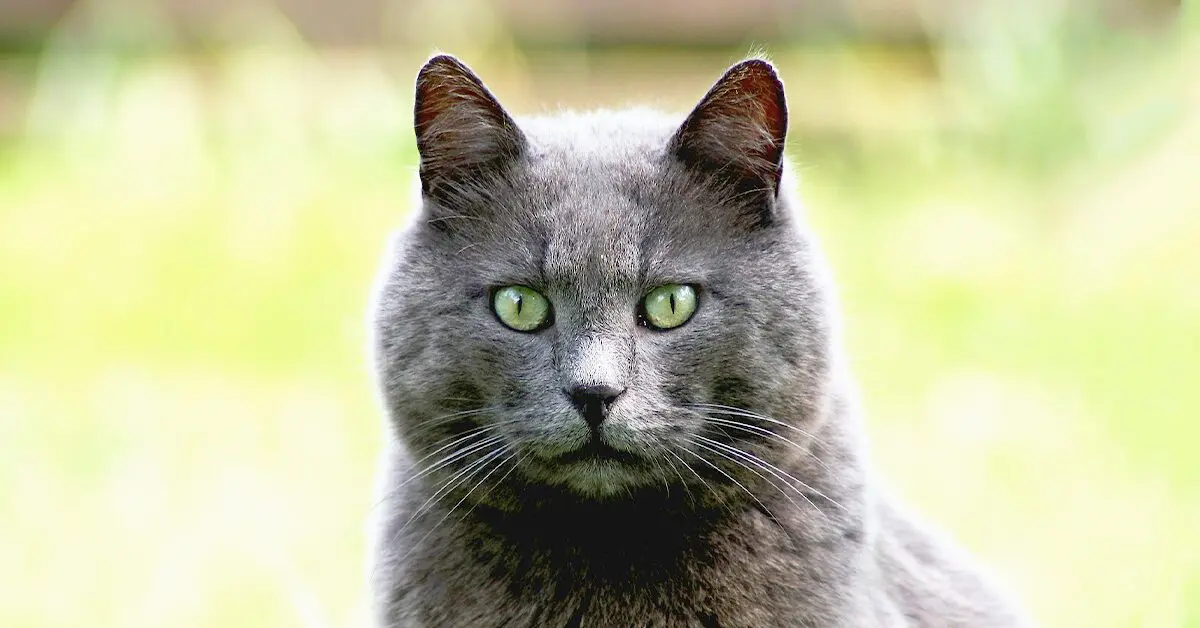
Meet the Russian Blue
Best Fur Friend
High Kitty I.Q.
Grooming Guru
Looking for a quiet, well-mannered breed with a sweet temperament? I’m the breed for you! We Russian Blues may seem aloof at first, but we’re just shy. It can take me time to get to know you, but once I do I’m super affectionate and playful (though I tend to pick a favorite human). I’m very calm and I like my surroundings to be calm too, so I don’t always do well with little kids or rambunctious pets.
I’m a smarty-pants so I need mental activity. I love playing fetch with my humans, puzzle toys, and cat trees! The rest of the time I am prrrfectly happy lounging in a sunbeam or snuggling with you. I’m not very chatty, but I like my daily routine – if you’re late at meal times you’ll get an earful from me! I’m a neat freak, too. I groom myself often and like when my human keeps things clean, especially my litter box! Humans fall in love with my elegant, one-of-a-kind looks (especially my bright blue coat and vivid green eyes) but it’s my gentle, sweet personality that wins their hearts.
Ready to learn more about me? Let’s dig in.
Ready to learn more about me? Let’s dig in.
 My Many Looks
My Many Looks
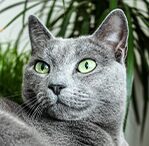
Light Silver Blue
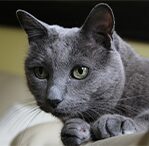
Silver Blue

Bright Blue
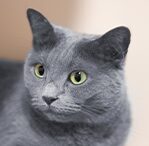
Slate Blue
 My Breed Characteristics
My Breed Characteristics
 Furbulous Fact
Furbulous Fact
If you usually get the itchies and sneezies around other cats, don’t worry – I’m prrrfect for humans with allergies! I am what they call a hypoallergenic breed, which means that my skin and saliva secrete very low levels of the protein Fel d 1, an allergen that can cause nasty reactions for humans. While none of us kitties are 100% hypoallergenic, I am about as good as it gets, so you can give me all the pets and snuggles you (and I) want!
 As I Grow Up
As I Grow Up
As you can see, we Russian Blues age pretty gracefully. Here are a few key milestones in my growth & development to be aware of as I grow up from a kitten to an adult and senior!
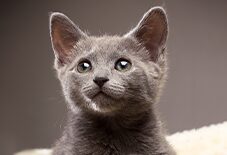
Kitten6 Mo-2 Yrs
I have a ton of energy as a kitty, so make sure I have outlets! A few daily play sessions, a box full of toys, and a cat tree should do the trick!
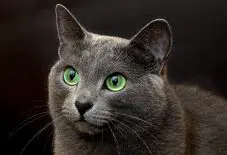
Adult3-4 Years
I have mellowed out and reached my large adult size! Keep an eye on my weight though because I’ve been known to get a little chunky.
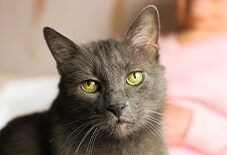
Senior11 Years
I’m 60 in human years, so teeth & gum issues may be on the way. Along with routine vet check-ups, pawlease brush my teeth regularly!
 History of My Breed
History of My Breed
We Russian Blues have an air of mystery about us, which is fitting because humans aren’t sure exactly how we came about. Most people believe that my earliest ancestors were native cats from the Archangel Isles (aka Arkhangelsk) in Northern Russia. This is a very cold region and our furbulous double coats would have protected us in the freezing temperatures. We are a stunning, elegant, and regal breed, so it’s no surprise that the humans believe that we are descended from cats kept by the Russian Czars. Humans think that we first left Russia around 1860 when Russian sailors took us with them to England and Northern Europe.
We made a splash when we were first exhibited at a cat show at London’s Crystal Palace in 1875. Then called the Archangel Cat, we were shown alongside the other blue cat breeds: Korat, Chartreux, and British Shorthair (aka British Blue). We may be the same color as those cats, but we have always been in a class of our own. The humans realized this in 1912 when they recognized us as our own separate breed. English and Scandinavian breeders worked to create the bloodline for today’s Russian Blues, but World War II interrupted the breeding program and we almost became extinct! The few of us that remained were outcrossed with blue-point Siamese and British Shorthairs.
My ancestors first came to America in the early 1900s but we didn’t really blow up until after World War II, when Americans started a breeding program. They used the European bloodlines to further develop our breed standard, especially our large ears, plush blue coat, and striking green eyes. We were officially recognized by the Cat Fanciers’ Association in 1949, and our popularity soared in America in the 1960s. Today, we are one of the CFA’s most popular (and beautiful) cat breeds!
 Pawesome Cats to Parent
Pawesome Cats to Parent
In addition to purebred Russian Blues like me, there are tons of prrrfectly sweet mixed-breed Russians that are looking to find their furever homes. You can learn where to find your next pet below!
 Care Tips
from Veterinarians
Care Tips
from Veterinarians 
A little grooming goes a long way.
Russian Blues require brushing and stroking to maintain the coat and should be bathed as needed. Russian Blues are generally clean animals who shed little. Their heavy coat helps to protect them against extreme weather conditions. - Gail Wolfe, DVM
Provide enrichment toys and play fetch.
Providing enrichment toys and food puzzles to mimic hunting is a great idea for indoor cats. You can take “brain games” to the next level with the Russian Blue and play fetch! This is great for exercise to maintain good body condition and to provide mental stimulation. - Stacy Choczynski, DVM
Promote bladder health through drinking.
Russian Blues may develop urinary tract disease and one way to promote bladder health is by promoting good drinking habits. Provide water dishes in peaceful areas of the home, consider palpable additives for the reluctant drinker, and consider running water options like a kitty fountain. - Stacy Choczynski, DVM

 Why Get Cat Insurance?
from Pumpkin®
Why Get Cat Insurance?
from Pumpkin®
While Russian Blues are a generally healthy breed, cat-astrophes can happen to any cat at any age. If your kitty gets hurt or sick, pet insurance can help you say ‘yes’ to the best care, even when it’s costly. When it comes to shopping for this breed, you’ll want to choose insurance plans like Pumpkin's, which can help cover the costs associated with the hereditary conditions Russian Blues are prone to developing. While a reputable breeder will conduct genetic testing on your kitty’s parents to help minimize the chances of passing down hereditary conditions, they can’t always be avoided. Let’s look at some common ones, and how Pumpkin Cat Insurance plans could help cover the cost of care!
 Heart Disease
Heart Disease
Russian Blues may develop heart problems, specifically Hypertrophic Cardiomyopathy (HCM). In this condition, the muscle walls of the heart thicken causing a decline in cardiac function. While there is no cure, heart disease can be managed with medication and dietary changes.
- Cost to Treat
- $500-$3,000
- Pumpkin Pays Back*
- $450-$2,700
 Bladder Stones
Bladder Stones
Russian Blues are prone to developing bladder stones, a urinary tract condition in which minerals build up and form stones that make urination extremely painful to impossible, depending on their size. While smaller stones can be removed via catheter, larger stones must be surgically removed.
- Cost to Treat
- $500-$3,500
- Pumpkin Pays Back*
- $450-$3,150
 Diabetes Mellitus
Diabetes Mellitus
Diabetes is a condition in which a cat does not produce the amount of insulin required to convert the glucose (sugar) in their blood into cellular energy. This can cause excessive urination, weight loss, and can lead to various infections. Diabetes requires lifelong treatment.
- Cost to Treat
- $500-$5,000
- Pumpkin Pays Back*
- $450-$4,500
 Periodontal Disease
Periodontal Disease
Like most cats, Russian Blues are prone to periodontal (gum) disease, which occurs when plaque builds up and forms a layer of tartar that inflames the gums. Left untreated, gums weaken and separate from teeth. While routine brushing, cleanings, and antibiotic gels help treat milder cases, severe ones require surgery.
- Cost to Treat
- $400-$1,200
- Pumpkin Pays Back*
- $360-$1,080
*Example illustrates reimbursement of a covered vet bill at a 90% reimbursement rate, where the annual deductible had already been satisfied and the annual limit had not yet been met. Coverage and reimbursement results vary based on policy options.

